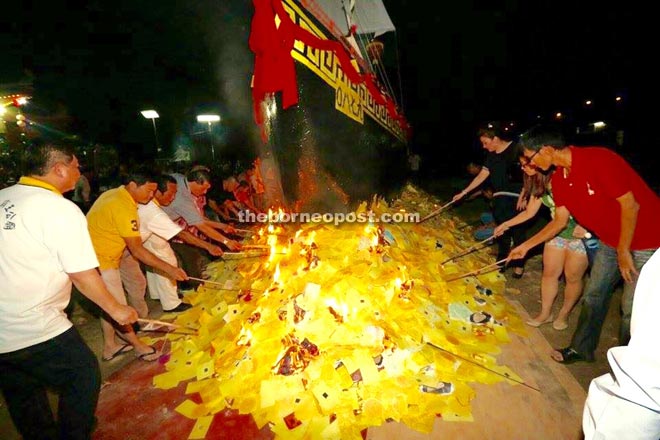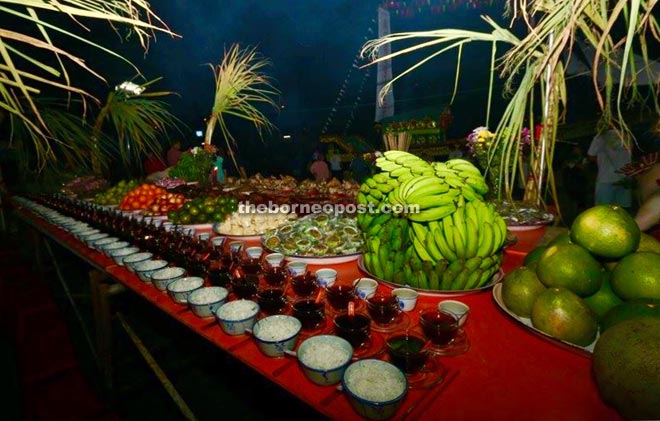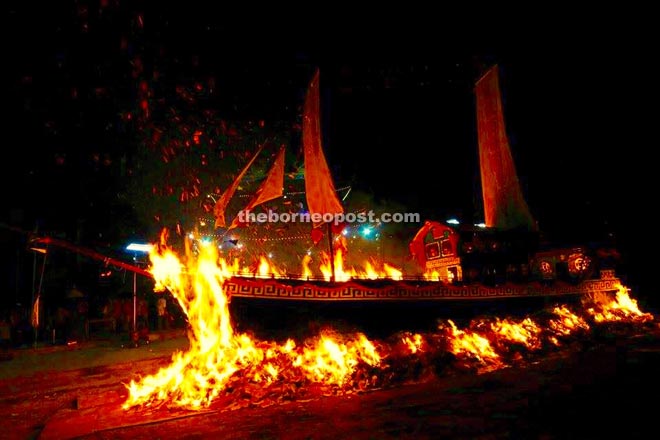
The burning of the paper Chinese junk at Er Par Hwang Temple near Deshon Road.

The offering of food and kopi-O is a common practice during the Hungry Ghost Festival in Sibu.

The paper junk being set aflame by temple committee members.
SIBU: The burning of the largest paper boat at the recent Hungry Ghost Festival might be the last for Er Par Hwang Temple at Deshon Road here.
This has been the cultural practice for some years, but the temple committee fears that they may have to stop it as new shophouses are sprouting next to the temple.
The construction of shophouses is currently in progress and upon its completion next year, the temple committee will have to give priority to public safety over the cultural practice.
Temple committee chairman Yong Keng Teck said: “The decision to stop the burning may have to be made next year. We shall access the situation in the next Hungry Ghost Festival, which falls on the 15th day of the seventh month of the Chinese lunar calendar.”
Yong said they were handed the tradition of burning the paper Chinese junk and regarded this as a practice unique to South East Asia.
When the Chinese arrived at the region around two centuries ago, they yearned to return to their ancestral land but most did not make it.
So when they died, their children burned paper boats as a symbolic ‘send-off’ to China.
“This practice has been handed down from generation to generation. We are now passing it to our children,” said Yong.
According to him, a paper boat generally measures 43 feet long, 10 feet wide and 28 feet tall.
“It is made of bamboo, paper and wood for easy burning. The paper Chinese junk is called ‘Sheng Bao’, which means ‘treasure in abundance’.”
The temple opened early Friday for worshippers to make offerings to the dead, especially those who had no descendants to care for them.
The celebration began at nightfall when committee members and worshippers lined up local food such as including fruits, ‘kuih’, cupcakes and rice, on a table for the wandering spirits.
Another interesting practice was the offering of ‘kopi-O’ (black coffee) among the items – a mark of the ‘kopitiam’ culture of Malaysia.
Worshipping and food offering continued until 9.15pm when committee members setting the paper junk aflame and let it ‘sail home’.
This was followed by ‘Qiang Gu’ – a ceremony where the faithful grabbed the food put up as offerings and bring it home.
It is believed that those who consume the offered food would be blessed with peace and harmony in their lives.
The Hungry Ghost Festival – also called ‘Zhong Yuan’ or ‘Yu Lan Festival’ – have been celebrated for thousands of years. It may have derived from both Buddhism and Taoism.
According to tradition, the festival marks the period when the gates of the ‘other world’ are opened, freeing the spirits and enabling them to wander into the human world.
In both Taoism and Buddhism, rituals such as the preparation of food offerings as well as the burning of incense and paper money, should be able to transmute and absolve the sufferings of the deceased.
